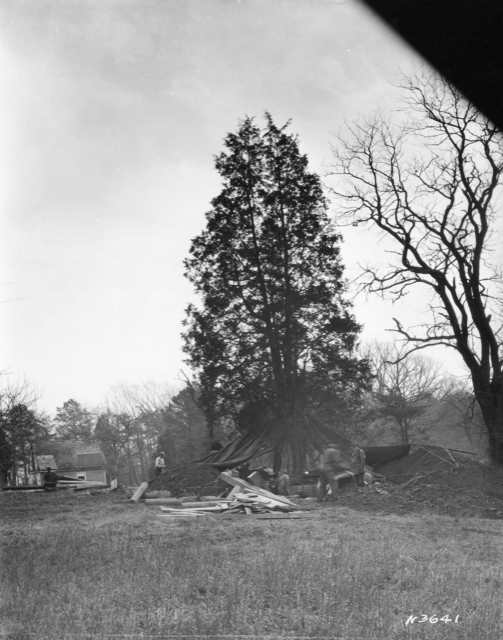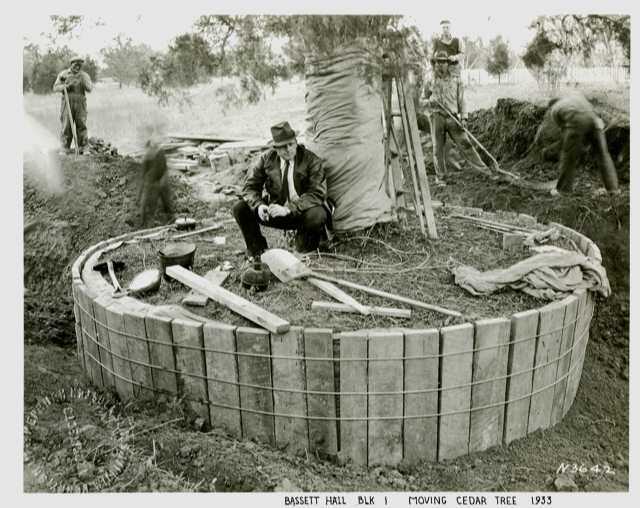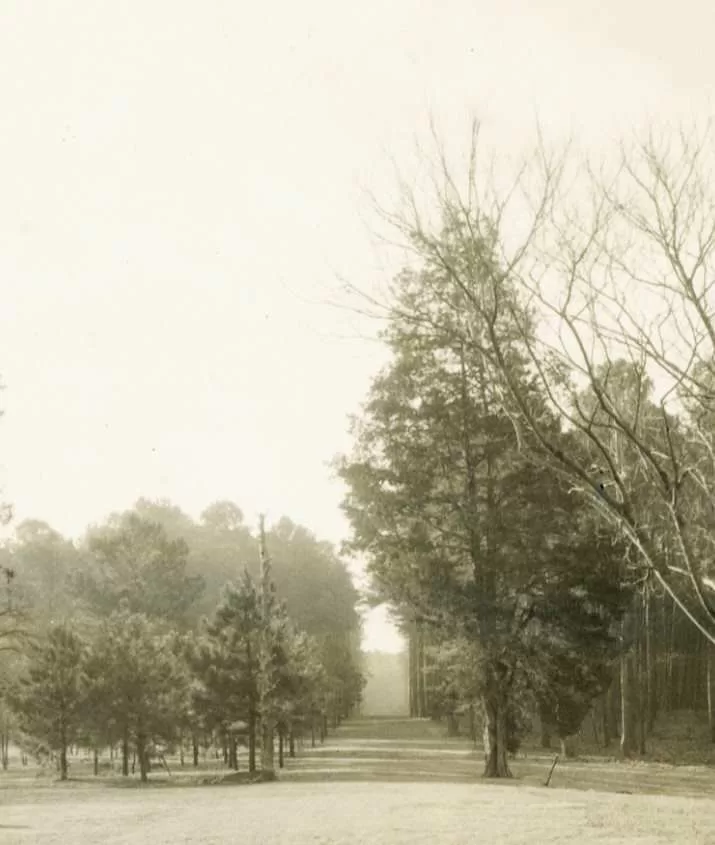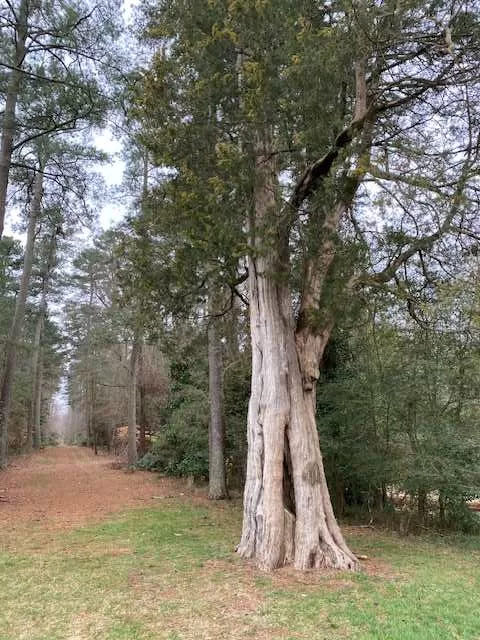Arthur A. Shurcliff’s Gift to the Future

“Moving Cedar Tree 1933” The Eastern redcedar being prepared for the move. A crew has dug around the roots and enclosed them for the move to its new location. Photo courtesy of the John D. Rockefeller Jr. Library and The Colonial Williamsburg Foundation.
A recent old photo that appeared on Facebook triggered a search through the Colonial Williamsburg Archives that led to the discovery of what may be the oldest living tree in this historic city. The photo, shown above, shows a group of workers standing in a very deep hole with the caption “Moving Cedar Tree 1933.” A comparison with that photo and an Eastern redcedar (Juniperus virginiana) standing behind Bassett Hall at the Northern entrance to the Rockefeller Vista, led to the discovery that it is in fact the same tree.
In 2023 I took my comparison photos to Laura Viancour, the former Colonial Williamsburg Landscape Director, who then made appointments for both of us to review archival material at the Rockefeller Library to determine if there was was more information to be discovered about this tree. The meticulous early landscape records kept by Arthur A. Shurcliff, the first Landscape Architect employed by John D. Rockefeller, Jr. during the early restoration efforts, yielded a treasure trove of photographs and file memos exchanged between Shurcliff and Rockefeller documenting the extraordinary efforts that were made to save that particular tree.
Both Mr. and Mrs. Rockefeller were keenly interested in the natural beauty of the woodlands behind Bassett Hall. During their bi-annual trips to visit Williamsburg to observe the progress on the restoration efforts commissioned by Mr. Rockefeller, they often walked the wooded trails laid behind Bassett Hall and took guests on horseback and carriage rides in that area. Mr. Rockefeller commissioned Mr. Shurcliff to cut a vista on a southern axis from the tea house or “orangery” they had built for a distance of about a ½ mile into the woods. The problem was that a number of existing trees blocked the view from the house and needed to be removed. There was one tree, however, that Shurcliff decided to be worth preserving. So, on January 3, 1933, Mr. Shurcliff wrote to the Williamsburg Holding Company for authorization to move that particular tree:
“This [big cedar] tree could not be cut like the few other trees that stood in the way, because it is too large and attractive. I told you the cost of moving this tree would be $75.00. The tree will be moved on this basis and will be in its new position within the time before the 25th.”
Work began in earnest to hand dig around the roots of this large Eastern redcedar in preparation for its transplanting to the new location.

The original location of the cedar to the east of Bassett Hall as digging begins. Photo courtesy of the John D. Rockefeller Jr. Library and The Colonial Williamsburg Foundation.
By January 27, 1933, the tree was in place at its present location at the northern terminus of the Rockefeller Vista, when back filling was completed.

Cedar after being moved and crew began filing around root base, January 27, 1933. Photo courtesy of the John D. Rockefeller Jr. Library and The Colonial Williamsburg Foundation.
This tree, although 90 years older, is now easily identified by comparing the photos taken in 1939 with today’s photos taken from approximately the same location.

Cedar relocated to its current position circa 1939. Photo courtesy of the John D. Rockefeller Jr. Library and The Colonial Williamsburg Foundation.
Having verified the location and identity of the cedar, the next task was estimating the age of the tree without having to core or cut into it. By employing a commonly accepted method of estimation used by the International Society of Arboriculture and the Morton Arboretum, an approximate age of a tree may be estimated by using the following formula:
circumference = 165.6” ÷ 3.1416 [pi] = 52.71” [diameter] X 5 [growth factor] = 260 (estimated age in years of the tree).
Using this method, Shurcliff’s cedar is believed to be the oldest living tree known to exist in Colonial Williamsburg, and, if so, is the only tree that has survived into modern times from the Colonial era. The Landscape & Horticulture Department is looking to schedule a visit from a dendrochronologist to provide a more scientific verification of this tree’s age in the near future.

Relocation completed circa 1939. Arthur A. Shurcliff is the gentleman in the dark overcoat on the left. Landscaping at Bassett Hall has been completed with the Rockefeller Vista clearly visible. Photo courtesy of the John D. Rockefeller Jr. Library and The Colonial Williamsburg Foundation.
As we approach the 250th anniversary of our independence and the 100th birthday of Colonial Williamsburg’s restoration, it is significant to consider that there may be a living tree that witnessed the birth of a nation, a war for our independence, a civil war, and that continues to thrive right here in the world’s largest living history museum. Arthur A. Shurcliff made a lasting gift to the future when he decided to transplant this “large and attractive” living witness to so much of our history. His vision surely confirms Rockefeller’s admonition, “That the future may learn from the past.”
Rick Brown, Colonial Williamsburg Volunteer and Tree Steward
Learn more: The Eastern Red Cedar: An Uncommonly Useful Tree

